History of Inauguration Day Weather in Washington, D.C.
Special Stories
20 Jan 2021 2:00 AM
[Information from NWS Baltimore/Washington] Every four years, people descend on Washington, D.C. to watch as the President of the United States of America swears to uphold the Constitution on the Capitol steps. Until 80 years ago, Presidential Inaugurations were held in early March, but were moved to January 20th in 1937 following the ratification of the 20th Amendment. This shortened the lame duck session between the election and Inauguration Day, but it placed the ceremony in the heart of winter.
On January 20th, the average high for the day is 43° with a low of 28° in Washington D.C. The normal weather at 12 p.m. EST has a temperature of 37° with partly cloudy skies and a wind chill of 31°. While that may sound like a nice winter day for the District of Columbia, some presidents have not been so fortunate.
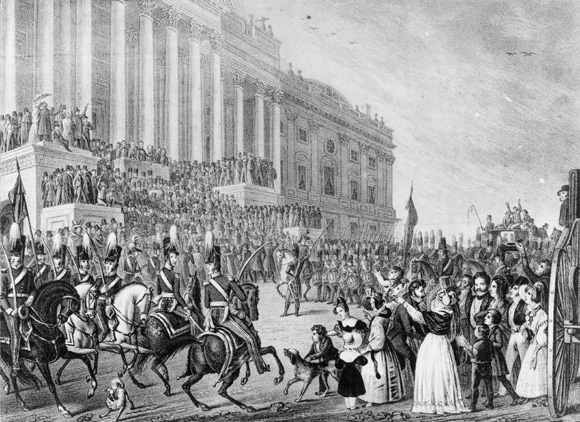 [Lithograph of the Presidential Inauguration of William Henry Harrison in Washington, March 4, 1841. From the Library of Congress]
In 1841, President William Henry Harrison was sworn into office on a cloudy, cold and blustery day. His speech lasted one hour and 40 minutes, and he rode a horse to and from the Capitol without a hat or overcoat. Pneumonia developed from a lingering cold he caught on that day, and he died just one month later.
President Franklin Pierce was sworn into office in 1853 on another cold and snowy day. He awoke to heavy snow in the morning which continued until about 11:30 am. Skies looked to be brightening by noon. Shortly after Pierce took his oath of office, as he began his inaugural address, snow started again. It came down heavier than ever dispersing much of the crowd and ruining plans for the parade. Abigail Fillmore, First Lady to the outgoing President Millard Fillmore, caught a cold as she sat on the cold, wet, exposed platform during the swearing-in ceremony. The cold developed into pneumonia and she died at the end of the month.
[Lithograph of the Presidential Inauguration of William Henry Harrison in Washington, March 4, 1841. From the Library of Congress]
In 1841, President William Henry Harrison was sworn into office on a cloudy, cold and blustery day. His speech lasted one hour and 40 minutes, and he rode a horse to and from the Capitol without a hat or overcoat. Pneumonia developed from a lingering cold he caught on that day, and he died just one month later.
President Franklin Pierce was sworn into office in 1853 on another cold and snowy day. He awoke to heavy snow in the morning which continued until about 11:30 am. Skies looked to be brightening by noon. Shortly after Pierce took his oath of office, as he began his inaugural address, snow started again. It came down heavier than ever dispersing much of the crowd and ruining plans for the parade. Abigail Fillmore, First Lady to the outgoing President Millard Fillmore, caught a cold as she sat on the cold, wet, exposed platform during the swearing-in ceremony. The cold developed into pneumonia and she died at the end of the month.
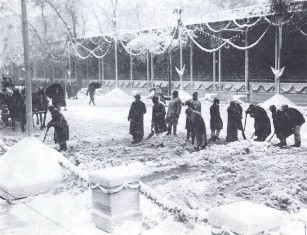 [Photo taken in front of Presidential Reviewing stand in 1909. From NWS]
In 1909, President William H. Taft's ceremony was forced indoors due to a storm that dropped 10" of snow over the Nation's Capital. The snow and winds began the day before. Strong winds toppled trees and telephone poles. Trains were stalled and city streets clogged. All activity was brought to a standstill. Sanitation workers shoveled sand and snow through half the night. It took 6,000 men and 500 wagons to clear 58,000 tons of snow and slush from the parade route. Despite the freezing temperatures, howling wind, snow, and sleet, a large crowd gathered in front of the Capitol to view the inauguration, but the weather forced the ceremony indoors. Just after the swearing-in, the snow tapered off.
[Photo taken in front of Presidential Reviewing stand in 1909. From NWS]
In 1909, President William H. Taft's ceremony was forced indoors due to a storm that dropped 10" of snow over the Nation's Capital. The snow and winds began the day before. Strong winds toppled trees and telephone poles. Trains were stalled and city streets clogged. All activity was brought to a standstill. Sanitation workers shoveled sand and snow through half the night. It took 6,000 men and 500 wagons to clear 58,000 tons of snow and slush from the parade route. Despite the freezing temperatures, howling wind, snow, and sleet, a large crowd gathered in front of the Capitol to view the inauguration, but the weather forced the ceremony indoors. Just after the swearing-in, the snow tapered off.
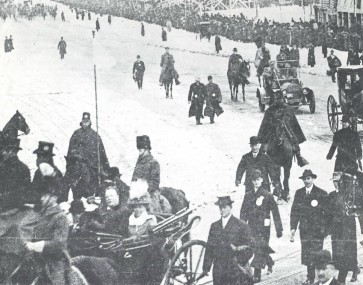 [President Taft and wife returning to White House after the ceremony. From NWS]
A washout occurred during President Franklin Delano Roosevelt's second inauguration in 1937. Between 11 am and 1 pm, 0.69" of rain fell. The ceremony began at 12:23 pm. The noon temperature was 33°. At the president's insistence, he rode back to the White House in an open car with a half an inch of water on the floor. Total rainfall for the day was a wet 1.77" and this amount remains as the record rainfall for January 20th.
[President Taft and wife returning to White House after the ceremony. From NWS]
A washout occurred during President Franklin Delano Roosevelt's second inauguration in 1937. Between 11 am and 1 pm, 0.69" of rain fell. The ceremony began at 12:23 pm. The noon temperature was 33°. At the president's insistence, he rode back to the White House in an open car with a half an inch of water on the floor. Total rainfall for the day was a wet 1.77" and this amount remains as the record rainfall for January 20th.
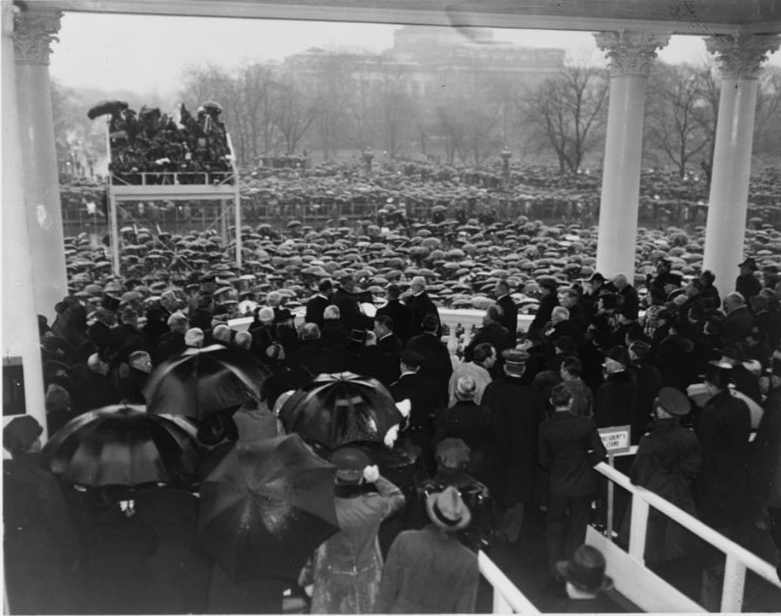 [Chief Justice Charles Evans Hughes administering the oath of office to Franklin Delano Roosevelt on the east portico of the U.S. Capitol, January 20, 1937. From the Library of Congress]
On the eve of the inauguration in 1961, 8 inches of snow fell and caused the most crippling traffic jam (for its time). Hundreds of cars were marooned and thousands of cars were abandoned. President-elect John F. Kennedy had to cancel dinner plans and, in a struggle to keep other commitments, is reported to have had only 4 hours of sleep. Former President Herbert Hoover was unable to fly into Washington National Airport due to the weather and he had to miss the swearing-in ceremony. By sunrise, the snow had ended and the skies were clearing, but the day remained bitter cold. An army of men worked all night to clear Pennsylvania Avenue. Despite the cold, a large crowd turned out for the swearing-in ceremony and inaugural parade. At noon, the temperature was only 22° and the wind was blowing from the northwest at 19 mph making it feel like the temperature was 7° above zero.
[Chief Justice Charles Evans Hughes administering the oath of office to Franklin Delano Roosevelt on the east portico of the U.S. Capitol, January 20, 1937. From the Library of Congress]
On the eve of the inauguration in 1961, 8 inches of snow fell and caused the most crippling traffic jam (for its time). Hundreds of cars were marooned and thousands of cars were abandoned. President-elect John F. Kennedy had to cancel dinner plans and, in a struggle to keep other commitments, is reported to have had only 4 hours of sleep. Former President Herbert Hoover was unable to fly into Washington National Airport due to the weather and he had to miss the swearing-in ceremony. By sunrise, the snow had ended and the skies were clearing, but the day remained bitter cold. An army of men worked all night to clear Pennsylvania Avenue. Despite the cold, a large crowd turned out for the swearing-in ceremony and inaugural parade. At noon, the temperature was only 22° and the wind was blowing from the northwest at 19 mph making it feel like the temperature was 7° above zero.
 [Heavy snow near the inauguration route in 1961. Image from U.S. Army Corps of Engineers.]
President Ronald Regan may have been the luckiest, as he had the warmest inauguration for his first term, with a temperatures of 55° under mostly cloudy skies. However, for his second term, he had the coldest in history, coming in at 7° with a wind chill ranging between 10° to 20° below zero. This prompted his inauguration to be moved indoors because of the extreme conditions.
[Heavy snow near the inauguration route in 1961. Image from U.S. Army Corps of Engineers.]
President Ronald Regan may have been the luckiest, as he had the warmest inauguration for his first term, with a temperatures of 55° under mostly cloudy skies. However, for his second term, he had the coldest in history, coming in at 7° with a wind chill ranging between 10° to 20° below zero. This prompted his inauguration to be moved indoors because of the extreme conditions.
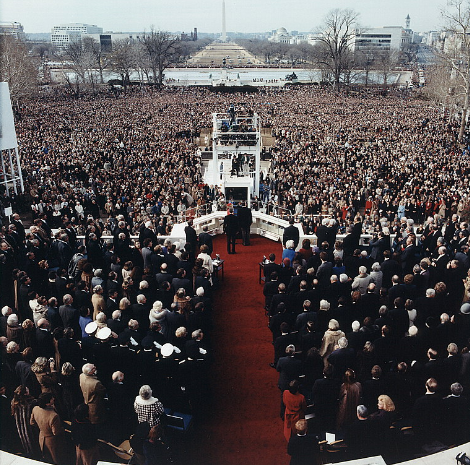 [Inauguration of Ronald Reagan on the west front of the U.S. Capitol, with the Washington Monument in the distance, January 20, 1981. From the Library of Congress]
[Inauguration of Ronald Reagan on the west front of the U.S. Capitol, with the Washington Monument in the distance, January 20, 1981. From the Library of Congress]
 [Lithograph of the Presidential Inauguration of William Henry Harrison in Washington, March 4, 1841. From the Library of Congress]
In 1841, President William Henry Harrison was sworn into office on a cloudy, cold and blustery day. His speech lasted one hour and 40 minutes, and he rode a horse to and from the Capitol without a hat or overcoat. Pneumonia developed from a lingering cold he caught on that day, and he died just one month later.
President Franklin Pierce was sworn into office in 1853 on another cold and snowy day. He awoke to heavy snow in the morning which continued until about 11:30 am. Skies looked to be brightening by noon. Shortly after Pierce took his oath of office, as he began his inaugural address, snow started again. It came down heavier than ever dispersing much of the crowd and ruining plans for the parade. Abigail Fillmore, First Lady to the outgoing President Millard Fillmore, caught a cold as she sat on the cold, wet, exposed platform during the swearing-in ceremony. The cold developed into pneumonia and she died at the end of the month.
[Lithograph of the Presidential Inauguration of William Henry Harrison in Washington, March 4, 1841. From the Library of Congress]
In 1841, President William Henry Harrison was sworn into office on a cloudy, cold and blustery day. His speech lasted one hour and 40 minutes, and he rode a horse to and from the Capitol without a hat or overcoat. Pneumonia developed from a lingering cold he caught on that day, and he died just one month later.
President Franklin Pierce was sworn into office in 1853 on another cold and snowy day. He awoke to heavy snow in the morning which continued until about 11:30 am. Skies looked to be brightening by noon. Shortly after Pierce took his oath of office, as he began his inaugural address, snow started again. It came down heavier than ever dispersing much of the crowd and ruining plans for the parade. Abigail Fillmore, First Lady to the outgoing President Millard Fillmore, caught a cold as she sat on the cold, wet, exposed platform during the swearing-in ceremony. The cold developed into pneumonia and she died at the end of the month.
 [Photo taken in front of Presidential Reviewing stand in 1909. From NWS]
In 1909, President William H. Taft's ceremony was forced indoors due to a storm that dropped 10" of snow over the Nation's Capital. The snow and winds began the day before. Strong winds toppled trees and telephone poles. Trains were stalled and city streets clogged. All activity was brought to a standstill. Sanitation workers shoveled sand and snow through half the night. It took 6,000 men and 500 wagons to clear 58,000 tons of snow and slush from the parade route. Despite the freezing temperatures, howling wind, snow, and sleet, a large crowd gathered in front of the Capitol to view the inauguration, but the weather forced the ceremony indoors. Just after the swearing-in, the snow tapered off.
[Photo taken in front of Presidential Reviewing stand in 1909. From NWS]
In 1909, President William H. Taft's ceremony was forced indoors due to a storm that dropped 10" of snow over the Nation's Capital. The snow and winds began the day before. Strong winds toppled trees and telephone poles. Trains were stalled and city streets clogged. All activity was brought to a standstill. Sanitation workers shoveled sand and snow through half the night. It took 6,000 men and 500 wagons to clear 58,000 tons of snow and slush from the parade route. Despite the freezing temperatures, howling wind, snow, and sleet, a large crowd gathered in front of the Capitol to view the inauguration, but the weather forced the ceremony indoors. Just after the swearing-in, the snow tapered off.
 [President Taft and wife returning to White House after the ceremony. From NWS]
A washout occurred during President Franklin Delano Roosevelt's second inauguration in 1937. Between 11 am and 1 pm, 0.69" of rain fell. The ceremony began at 12:23 pm. The noon temperature was 33°. At the president's insistence, he rode back to the White House in an open car with a half an inch of water on the floor. Total rainfall for the day was a wet 1.77" and this amount remains as the record rainfall for January 20th.
[President Taft and wife returning to White House after the ceremony. From NWS]
A washout occurred during President Franklin Delano Roosevelt's second inauguration in 1937. Between 11 am and 1 pm, 0.69" of rain fell. The ceremony began at 12:23 pm. The noon temperature was 33°. At the president's insistence, he rode back to the White House in an open car with a half an inch of water on the floor. Total rainfall for the day was a wet 1.77" and this amount remains as the record rainfall for January 20th.
 [Chief Justice Charles Evans Hughes administering the oath of office to Franklin Delano Roosevelt on the east portico of the U.S. Capitol, January 20, 1937. From the Library of Congress]
On the eve of the inauguration in 1961, 8 inches of snow fell and caused the most crippling traffic jam (for its time). Hundreds of cars were marooned and thousands of cars were abandoned. President-elect John F. Kennedy had to cancel dinner plans and, in a struggle to keep other commitments, is reported to have had only 4 hours of sleep. Former President Herbert Hoover was unable to fly into Washington National Airport due to the weather and he had to miss the swearing-in ceremony. By sunrise, the snow had ended and the skies were clearing, but the day remained bitter cold. An army of men worked all night to clear Pennsylvania Avenue. Despite the cold, a large crowd turned out for the swearing-in ceremony and inaugural parade. At noon, the temperature was only 22° and the wind was blowing from the northwest at 19 mph making it feel like the temperature was 7° above zero.
[Chief Justice Charles Evans Hughes administering the oath of office to Franklin Delano Roosevelt on the east portico of the U.S. Capitol, January 20, 1937. From the Library of Congress]
On the eve of the inauguration in 1961, 8 inches of snow fell and caused the most crippling traffic jam (for its time). Hundreds of cars were marooned and thousands of cars were abandoned. President-elect John F. Kennedy had to cancel dinner plans and, in a struggle to keep other commitments, is reported to have had only 4 hours of sleep. Former President Herbert Hoover was unable to fly into Washington National Airport due to the weather and he had to miss the swearing-in ceremony. By sunrise, the snow had ended and the skies were clearing, but the day remained bitter cold. An army of men worked all night to clear Pennsylvania Avenue. Despite the cold, a large crowd turned out for the swearing-in ceremony and inaugural parade. At noon, the temperature was only 22° and the wind was blowing from the northwest at 19 mph making it feel like the temperature was 7° above zero.
 [Heavy snow near the inauguration route in 1961. Image from U.S. Army Corps of Engineers.]
President Ronald Regan may have been the luckiest, as he had the warmest inauguration for his first term, with a temperatures of 55° under mostly cloudy skies. However, for his second term, he had the coldest in history, coming in at 7° with a wind chill ranging between 10° to 20° below zero. This prompted his inauguration to be moved indoors because of the extreme conditions.
[Heavy snow near the inauguration route in 1961. Image from U.S. Army Corps of Engineers.]
President Ronald Regan may have been the luckiest, as he had the warmest inauguration for his first term, with a temperatures of 55° under mostly cloudy skies. However, for his second term, he had the coldest in history, coming in at 7° with a wind chill ranging between 10° to 20° below zero. This prompted his inauguration to be moved indoors because of the extreme conditions.
 [Inauguration of Ronald Reagan on the west front of the U.S. Capitol, with the Washington Monument in the distance, January 20, 1981. From the Library of Congress]
[Inauguration of Ronald Reagan on the west front of the U.S. Capitol, with the Washington Monument in the distance, January 20, 1981. From the Library of Congress]
Inaugural Weather Highlights
1817 = First outdoor inauguration. President James Monroe was sworn into office. 1873 = Coldest March 4th inauguration. Noon temperature was only 16° with a record low temperature for March of 4°. Sunshine was no help as the wind made it bitterly cold. President Ulysses S. Grant was sworn into office for his second term. 1909 = Most snow with 9.8". Also very strong winds. President William H. Taft was sworn into office. 1913 = Warmest March 4th inauguration. Noon temperature was 55°. 1937 = First inauguration held on January 20th. 1937 = Record rainfall. It was President Franklin D. Roosevelt's second inauguration. A total rainfall of 1.77" fell that cold day. Between 11 am and 1 pm, 0.69" of rain fell with a noon temperature of 33°. 1961 = 8" inches of fresh snow laid on the ground for President John F. Kennedy's inauguration. 1981 = Warmest January inauguration. Noon temperature was 55°. It was Ronald Reagan's first inauguration and would greatly contrast his second inauguration listed below. 1985 = Coldest January inauguration (Jan. 21). Noon temperature was only 7°. The morning low temperature was -4° and the afternoon high was only 17°. Wind chill temperatures in the afternoon were in the -10 to -20° range. It was Ronald Reagan's second inauguration ceremony. For a look at the weather on each Inauguration Day, click here for more from the National Weather Service Baltimore/Washington.All Weather News
More